
Bird Photography Tour



INTRODUCTIONThis article is
intended
as both a travel log for my recent 2-week trip to Florida and also a
resource
for those planning a birding or bird-photography trip to the Sunshine
State. During my trip I encountered many other photographers and
birders, and collected many useful tips on photographing birds in this
state, including the locations of numerous other sites that weren’t
originally on my itinerary. This information is difficult to find
on the internet without spending many hours browsing through forums and
the like. Hopefully this article will save you some time if
you’re planning such a trip.
The photos accompanying this article were all taken by me at the described locations, and should give you some indication of the types of images you can reasonably expect to get on a short trip, with reasonably good equipment. Keep in mind that many of the other site guides you’ll find on the internet feature images taken by local residents who can afford to spend hundreds of hours out in the field capturing prize-winning images, which won’t in general be representative of what you can reasonably expect to get yourself during a whirlwind tour of a dozen sites spanning hundreds of miles, during a brief two-week vacation. In contrast, the images you see here should be somewhat more representative of what a serious birder can collect on a short trip, though it should be noted that I did work very hard to collect these images and I do have very good equipment, so you may need to adjust your expectations accordingly. Some Useful Statistics During my 14-day trip I took a total of 30,798 photos (yes, that’s thirty thousand), averaging about 2,200 photos per day. The most photos I took in a day was 4,494 (Little Estero + Sanibel), and the least was 1,023 (Tigertail + Corkscrew). The 30,000+ photos took up somewhat less than half a terabyte (358 GB). After returning home, I spent two weeks browsing through those images to select the 191 photos included in this report. I shot everything in RAW (10 Megapixels) and backed up all photos daily onto twin 1 TB external USB drives. In the field I kept 8 memory cards (8 GB each), which I never filled up completely in one day. The drive down from Durham (NC) to Miami was 824 miles, and took about 12 and a half hours, which I made in two trips (stopping for the night in Orlando). Hundreds of miles of additional driving were required to get from site to site, and in commuting to/from the hotel each morning and evening. I stayed in four different hotels, working only the sites nearest my current hotel before moving on to the next hotel and the next set of nearby birding sites. I birded a total of 14 different sites. Hotel costs totaled roughly $2000. Note that I was limited in my hotel options, since my "significant other" happens to be a labrador retriever. Costs for toll roads in Florida were easily well over $100. Cheap food and beer were easy to find; gasoline was around $2/gal, and my compact car used up plenty of it... This journal is split
into 14 pages, by entry date.
Skip Directly to
an Entry:
By Page:
2 | 3 | 4 | 5 | 6 | 7 | 8 | 9 | 10 | 11 | 12 | 13 | 14 By Location: | Key Largo | Anhinga Trail | Flamingo | Eco Pond | | Shark Valley | Tigertail Beach | Corkscrew Swamp | | Estero Lagoon | Cape Coral | Sanibel | Venice Rookery | | For Desoto | Merritt Island | Gatorland | 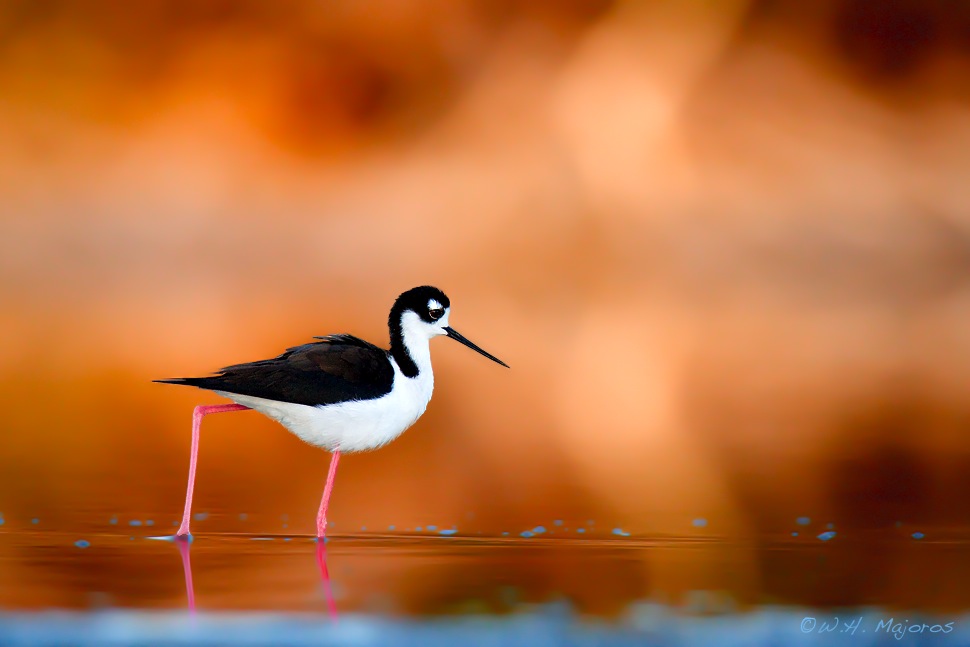 Black-necked Stilt at Eco Pond in the Everglades. 840mm wide-open at f/5.6. 1/1000 sec, set manually, at ISO 1250. No flash. Information on the photographic equipment used on this trip is available here. See also my new book: TRAVEL
LOG
|
||||||||
| Feb 26 Thursday 1348 photos |
On
the drive from Orlando to Miami, I spotted the only Sandhill Crane seen
during my entire trip —
unfortunately, I was doing 75 mph on a toll
road (rt. 91) and couldn’t pull over to get a photo. As soon as I
entered Florida I did notice that there were quite a number of active
osprey nests along the highway. Back up in North Carolina,
ospreys won’t be nesting for several months yet. My first stop was at the bridge to Islamorda in the Keys (off the southernmost tip of Florida), where I let my dog swim in the clearest water I’ve ever seen: 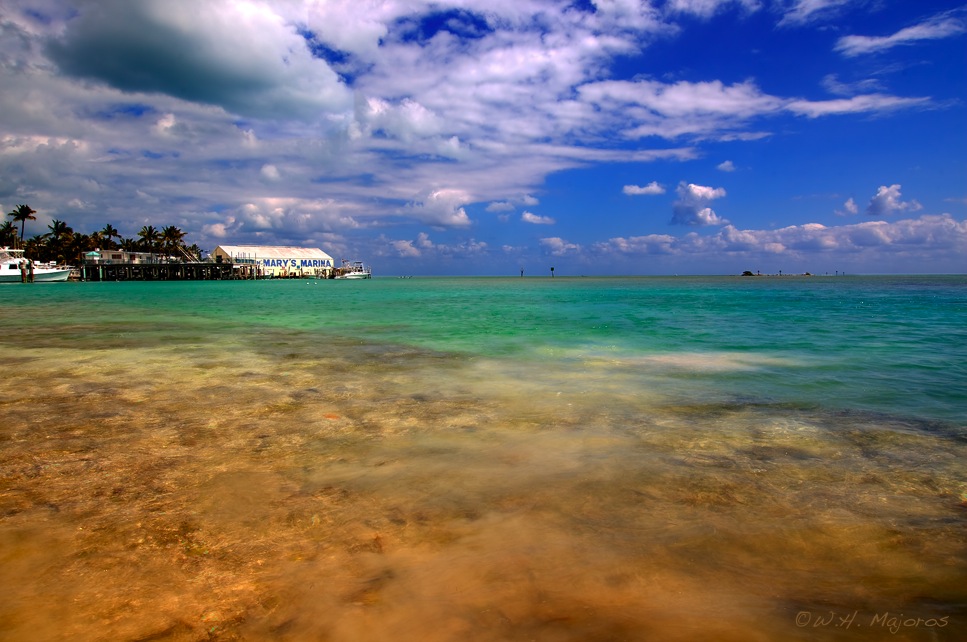 Ocean view from
Islamorda in the Florida Keys.
Canon EOS 1D Mark III camera, Tokina 12-24mm wide-angle lens. Focal length 18mm, f/9, ISO 250. HDR composite from three exposures (1/4000 sec, 1/1250 sec, 1/400 sec). Hand-held. I ended up wading in the water myself to get this photo (above) — something I would never consider doing in North Carolina in February. I then backtracked to the Wild Bird Center in Key Largo (actually, Tavernier), where I spent the afternoon photographing wild birds at extremely close ranges. The center is actually a bird rehabilitation facility, but at 3:30pm every day they throw fish to the wild pelicans out on the beach, who eagerly line up for the free food. The photo below is a bit blurry because I only shot it for illustration purposes and wasn’t concerned about quality: 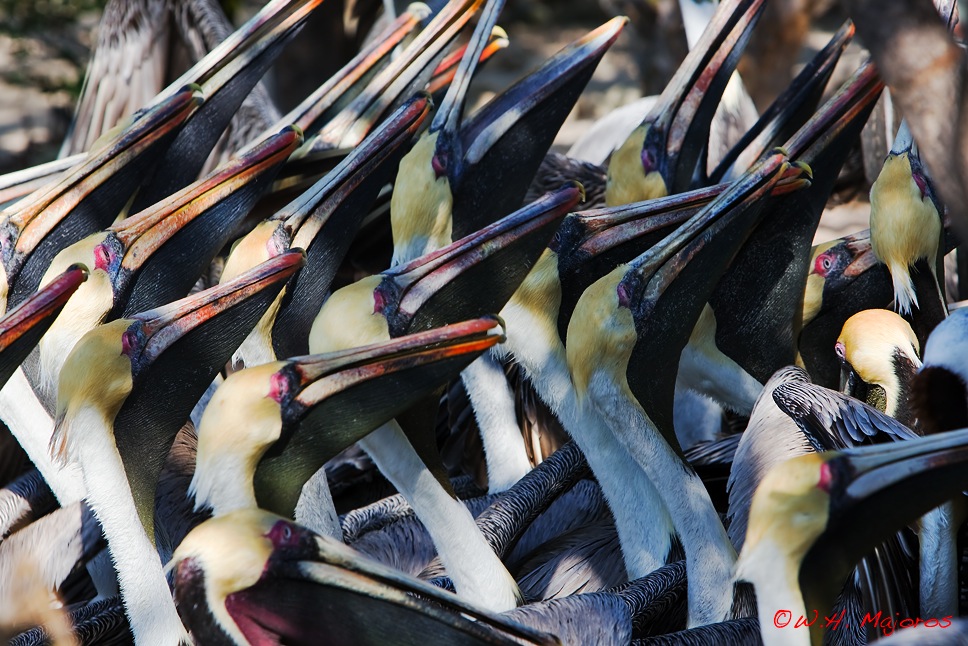 Pelican feeding
frenzy at Wild Bird Center in Key Largo.
Canon 70-200mm f/2.8 lens at 200mm, f/7.1. 1/500 sec, set manually. ISO 320. No flash. About 45 minutes prior to feeding time, the pelicans start to come in to the beach area of the center in droves. It occurred to me that I might be able to get some good pelican flight shots showing the birds coming in for a landing head-on, though the angle of light from the sun made that a bit tough. By wading out a bit into the water and hunkering down against the center’s beach cages I was able to get one or two decent shots, though many showed poorly-lit undersides of birds. Through a combination of a lucky angle and strong fill flash I was able to light up the underside of this bird fairly well, though some of the highlights in the head got blown: 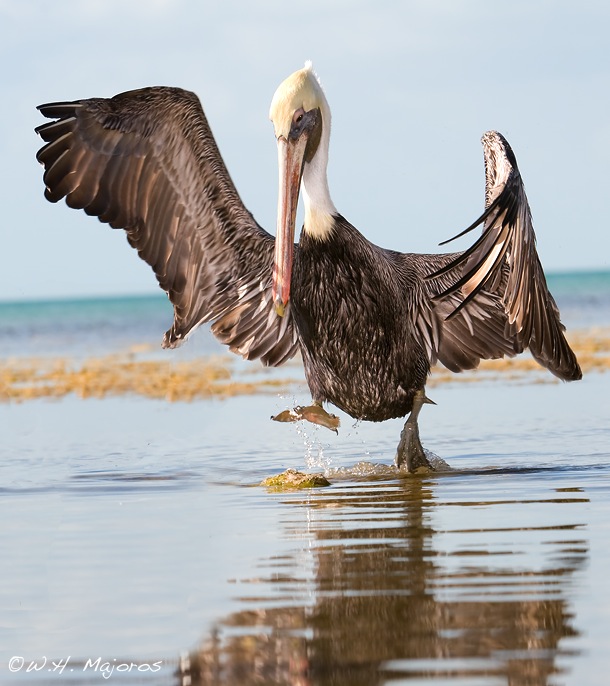 Pelican landing
at Wild Bird Center, Key Largo.
70-200mm f/2.8L lens at 130mm, f/7.1. 1/1000 sec (manual), ISO 320. Fill flash on high-speed sync at +3. Later in the afternoon, as the sun fell toward the horizon, I explored my options for some back-lit photography. A handful of snowy egrets provided willing subjects at close range: 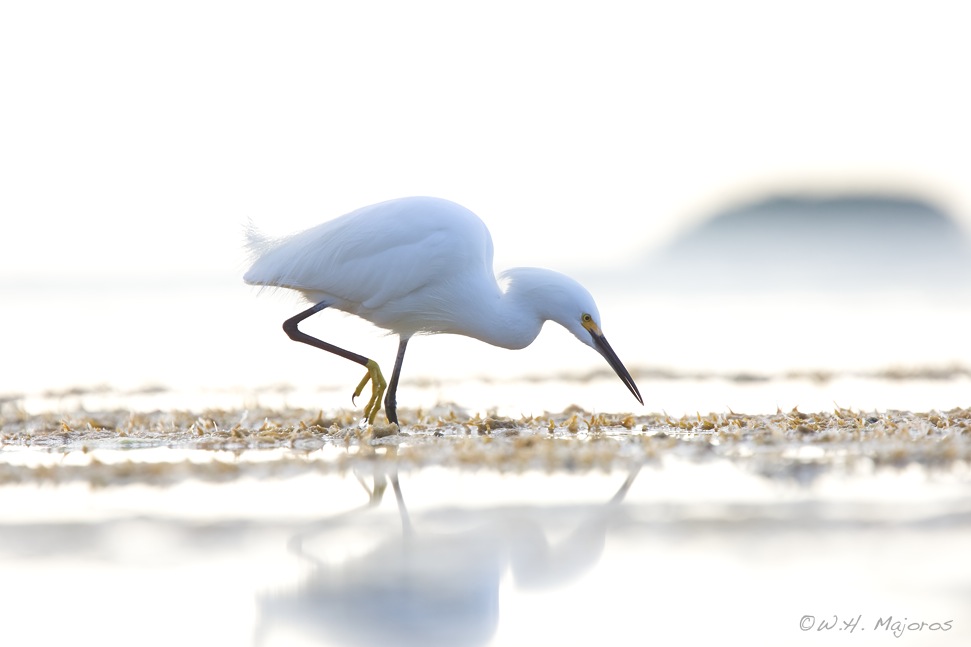 Snowy Egret at
Wild Bird Center, Key Largo.
400mm at f/5. 1/500 sec (manual), ISO 320. No flash. It’s interesting to contrast the above photo with the one shown below, which was taken just a few minutes later. Whereas the bird above was in front of the sun, providing a uniform white background via reflections in the water, the bird below was photographed with the sun at my back. Both shots were taken at a fairly wide aperture of f/5, accounting for the blurred foregrounds and backgrounds. Note also that both photos were taken with the camera at roughly eye-level with the bird. In order to do this I had to squat so low in the water that my rear-end got quite soaked (to the amusement of some of the tourists). 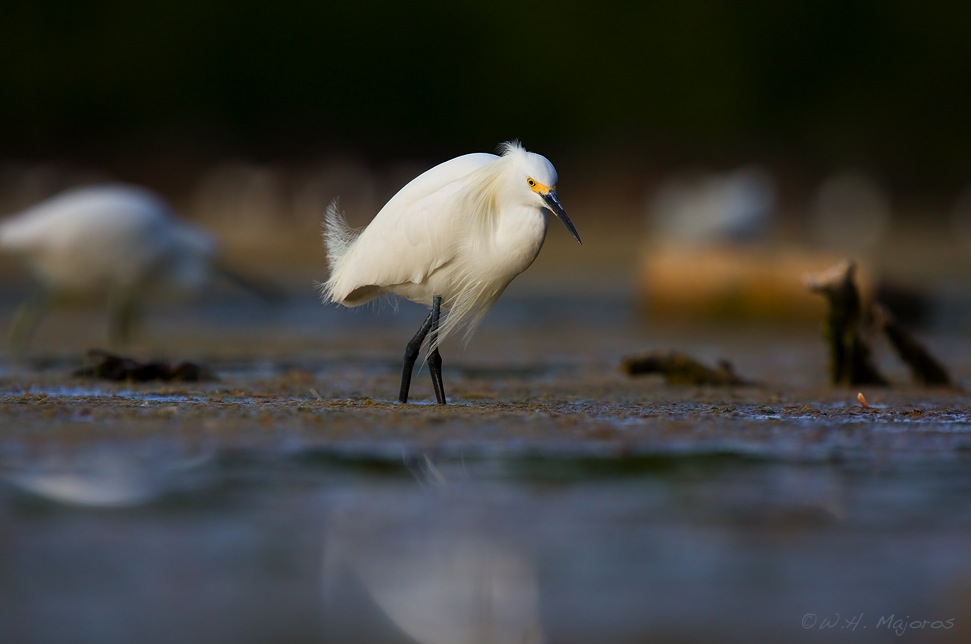 Snowy Egret at
Wild Bird Center, Key Largo.
400mm f/5, 1/1600 sec (manual), ISO 320. No flash. A bit earlier in the afternoon I got some close-up head shots of the pelicans by using a 1.4x teleconverter on my 400mm lens (see below). Note that at the Wild Bird Center on Key Largo, you can get shots like this with much smaller focal lengths up on the boardwalk, since the birds will literally waddle right up to you and let you take their picture at point-blank range. Getting a head shot with blue sky in the background was easier out on the beach, though, and there I needed the larger focal length. 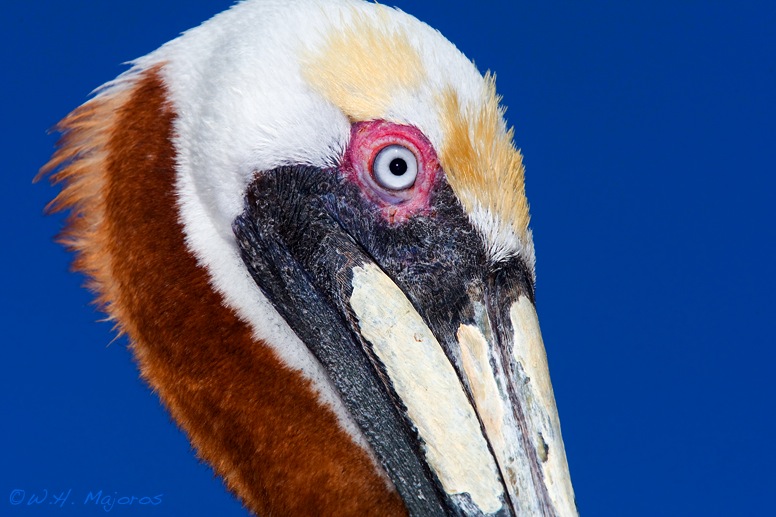 Brown Pelican
Head Shot.
Canon 400mm f/4DO lens + 1.4x teleconverter. 560mm at f/11, 1/2000 sec (manual), ISO 500. Flash on high-speed sync at +3. The kind, old woman who apparently runs this place informed me that they have one of the very best vantage points for sunsets anywhere in the Keys. Fortunately, the Center doesn’t have strict opening or closing times (there are no gates on the boardwalk or in the parking lot or driveway), so you’re free to hang out and catch the sunset out on the beach with the birds: 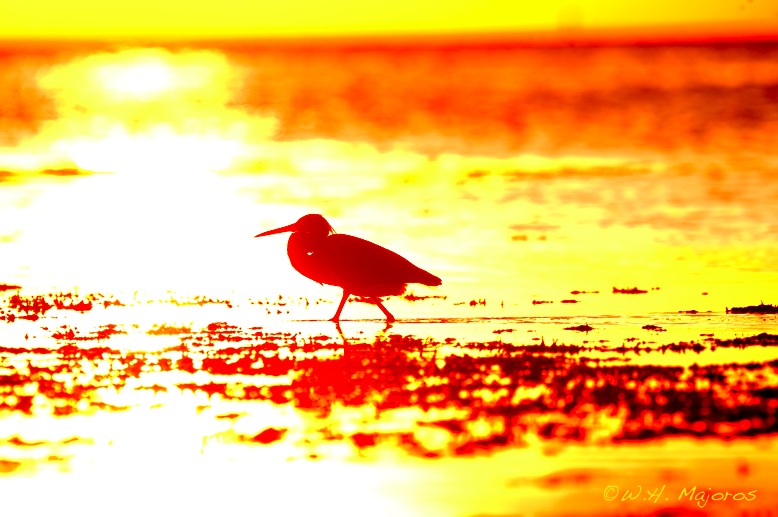 Tri-colored Heron
at Sunset.
400mm at f/6.3. 1/800 sec (set manually), ISO 400. Below you can see a more expansive view of the ocean at the Center. The wooden contraption in the foreground is some sort of platform which the pelicans like to congregate on in the early afternoon. The water at mid-tide is low enough that you can easily wade out there to photograph them if you like.  Sunset at Wild
Bird Center, Key Largo.
Tokina 12-24 wide angle lens at 20mm, ISO 400. Hand-held. HDR image composed from five apertures (f/13, f/9, f/6.3, f/4.5, f/4). All-in-all, today’s trip to the Wild Bird Center at Key Largo was very pleasant. In the days to come, I will return here several times to pursue the many photographic opportunities this place offers. Some quick notes on the Center: entry is free, though a $5 donation is requested (I gave more than that); the staff are mostly very pleasant and highly accommodating and eager to please; the parking lot is, unfortunately, miniscule — I seem to recall that it had no more than about 8 or 10 parking spaces, so if you plan on being there for feeding time, you might want to try to get a space by about 2pm or so. |
|
|
|
|
|
|
